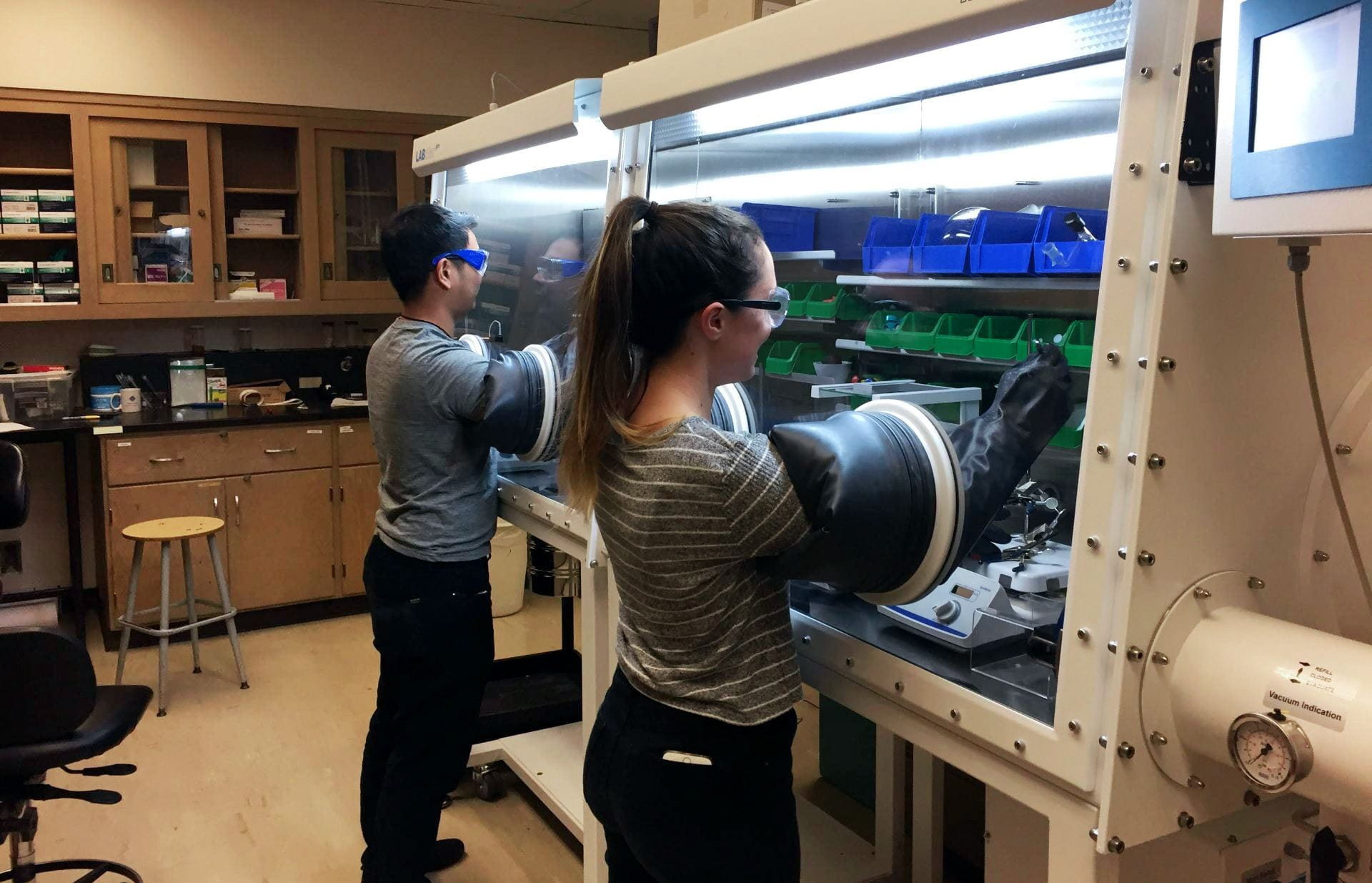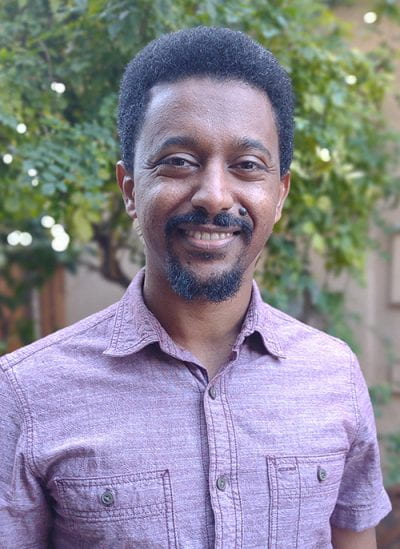What Early-Career Funding Means to 3 SJSU Researchers

Students working in 2018 in the research lab of Madalyn Radlauer, assistant professor of chemistry at SJSU. Radlauer received a National Science Foundation grant in 2021. (Photo courtesy of Madalyn Radlauer)
As part of its strategic plan, San José State University is investing time and resources to help faculty secure funding for cutting-edge research. Recently, three faculty members in the College of Science secured grants from the National Science Foundation (NSF).
But these successes are particularly exciting, because these faculty earned grants that are new to SJSU and received funding at earlier points in their careers than is typical, explained Miri VanHoven, associate dean for research in the College of Science.
Hilary Hurst, assistant professor of physics and astronomy; Kassahun Betre, assistant professor of physics and astronomy; and Madalyn Radlauer, assistant professor of chemistry, each received NSF grants to fund their research in early fall 2021.
Betre and Radlauer both received grants from a brand-new source of funding from the NSF: the Launching Early-Career Academic Pathways in the Mathematical and Physical Sciences (LEAPS-MPS) grant. This grant is designed to support faculty at institutions that don’t often receive a significant amount of NSF funding in math and physical sciences, such as some minority-serving institutions (MSI) and predominantly undergraduate institutions (PUIs). SJSU is both an MSI and PUI.
The grant program also seeks to broaden participation from groups typically underrepresented in math and physical sciences.
Hurst received the NSF Research Traineeship (NRT) grant, which funds initiatives that will develop new ways of training graduate STEM students for careers in research or the private sector. Rather than funding a single research project, the NRT funds a series of initiatives designed to transform graduate STEM education, such as developing new courses and innovative research collaborations.
Richard Mocarski, associate vice president for research at SJSU, noted that securing research funding isn’t easy, and it’s often a huge trial-and-error process.
“The federal funding landscape is incredibly competitive and each and every award comes not just from the work that went into writing the particular grant, but from the years of lab work and the many iterations of the project as it has developed,” he said.
“The success of Drs. Betre, Radlauer and Hurst at such an early stage from NSF is a testament to their talent and perseverance. Furthermore, these grants will provide platforms for both these faculty and SJSU students to be leading the conversations in their fields.”
VanHoven added that “earning these NSF awards as young faculty within their first five years at SJSU is an amazing achievement.”
The LEAPS-MPS grants “are critical for the success of the students working with them,” she said. The NRT funding “usually goes to faculty at PhD-granting institutions to support students earning PhDs.” She said that also emphasizes the importance of Hurst’s research and its potential impact.
While their areas of research are distinct, Hurst, Betre and Radlauer have much in common: All three joined SJSU within the last five years; all are passionate about working with students; and all give credit to SJSU’s University Grant Academy (UGA) for giving them the tools to secure their funding. The UGA is a resource within the Office of Research that helps faculty through the process of writing grant proposals to fund their research, scholarship and creative activities.
Fortifying Quantum Tech

Hilary Hurst, assistant professor of physics and astronomy
Researcher: Hilary Hurst, assistant professor of physics
Grant: NSF Research Traineeship (NRT), About $739,000 over five years
About the research
“My research focuses on how to make quantum technologies more robust against environmental disturbances,” explained Hurst. “Imagine if your computer stopped working just because you shone some light on it that was a little too bright. That would be a problem, right? That’s what happens with quantum computers today — they are super fragile, and unwanted noise can lead to errors in the computation. I’m studying ways to get around this problem.”
Impacting the future of technology
Hurst said the NRT will partially fund this research and also provide resources to develop new courses at SJSU dedicated to quantum technology.
“We are training a new ‘quantum workforce,’ which is a major NSF and U.S. government priority. It is also important that students from diverse backgrounds learn about and join this field as it grows.”
Hurst added that new technologies based on quantum physics can lead to much more powerful computers and sensors.
“While the average person may not directly see the impact of these technologies in everyday life, they will help us to understand and solve outstanding problems in a range of fields from chemistry to cybersecurity.”
What makes this grant different
“This award is unique because it’s a collaboration between SJSU and the Colorado School of Mines, totaling $3 million in funding. Through this program, SJSU graduate students will have the opportunity to study and do research in quantum science at Mines for a semester, in addition to new opportunities in quantum research at SJSU.
“I feel very fortunate to be able to work with my excellent colleagues at SJSU and Mines on this ambitious project. An award this large in scope cannot be completed by a single person, and having a team of folks who care about quantum education, in addition to quantum research, is really exciting and one of the reasons I joined SJSU.”
Exploring Quantum Theories

Kassahun Betre, assistant professor of physics
Researcher: Kassahun Betre, assistant professor of physics
Grant: LEAPS-MPS, About $172,000 over two years
About the research
“My research is in theoretical particle physics, specifically in quantum gravity — an area that aims to understand the structure of space and time at the smallest scales.” Betre’s research looks at the specific ways space and time could emerge “from discrete building blocks that interact with each other in simple ways.” Betre compared the particular process he is studying to the way water molecules shift from a liquid to a solid state and a rigid appearance emerges when freezing.
What makes this research important
The best theory we have about the nature of space and time comes from Einstein’s general theory of relativity, Betre explained. “Though immensely successful and popular, Einstein’s theory leaves some important questions unaddressed.” A big one, he noted, is the nature of black holes and how they form and disappear.
What earning this grant means
“It has affirmed that the research I’m pursuing is worthwhile, and this will provide me support to push it forward. Results I get from the research funded by this grant can be the basis for further grant proposals. Receiving the award during my first year at San José State has launched my SJSU career into high gear.”
Developing Greener Chemistry

Madalyn Radlauer, assistant professor of chemistry
Researcher: Madalyn Radlauer, assistant professor of chemistry
Grant: LEAPS-MPS, Nearly $250,000 over two years
About the research and its wider impact
Radlauer is trying to make certain chemical reactions more environmentally friendly. She studies chemical reactions driven by catalysts, where each catalyst molecule can do the reaction hundreds or thousands of times. For this project, she’s targeting a system using multiple catalysts at once. Using multiple catalysts over and over can help minimize impact, she explained.
“Often it takes more than one step to go from your starting materials to your desired product,” Radlauer said.
“When we design catalysts for a specific reaction, we often think of them individually, but if we could run several reactions in a single reactor or ‘pot’ — and run the reactions in tandem — then we could reduce the resources and expense to access a particular product and significantly reduce the environmental impact of doing the reaction,” said Radlauer.
“This is an especially important aspect when the catalyst is expensive or contains an atom that is more rare; many catalysts use elements like palladium, platinum, or gold, but because they can be used over and over, this can still be feasible.”
Radlauer said that achieving those tandem chemical reactions could “greatly benefit society through enabling greener chemistry for fuel production.”
On earning the NSF grant at this point in her career
“It’s amazing, exciting and intimidating to me whenever someone believes in my ideas and potential,” she said. “Part of me celebrates and part of me immediately starts worrying how I’m going to pull it off.”
Bringing students into the research
“Working with SJSU students is the best part of doing research here, and I have had the immense privilege of working with a great group,” shared Radlauer. “The preliminary results that my first students acquired are part of what made getting this funding possible.”
She added that in her nearly five years at San José State, she has worked with close to 40 undergraduate and graduate students, including those in her current group. They conduct most of the experiments, while her role is to train and guide them.
“I also maintain and organize the lab and do some of my own experiments, but I try to use these as training opportunities so that the students are exposed to all of the techniques and instruments relevant to carrying out the research.”




